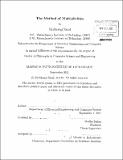The method of multiplicities
Author(s)
Saraf, Shubhangi
DownloadFull printable version (4.495Mb)
Other Contributors
Massachusetts Institute of Technology. Dept. of Electrical Engineering and Computer Science.
Advisor
Madhu Sudan.
Terms of use
Metadata
Show full item recordAbstract
Polynomials have played a fundamental role in the construction of objects with interesting combinatorial properties, such as error correcting codes, pseudorandom generators and randomness extractors. Somewhat strikingly, polynomials have also been found to be a powerful tool in the analysis of combinatorial parameters of objects that have some algebraic structure. This method of analysis has found applications in works on list-decoding of error correcting codes, constructions of randomness extractors, and in obtaining strong bounds for the size of Kakeya Sets. Remarkably, all these applications have relied on very simple and elementary properties of polynomials such as the sparsity of the zero sets of low degree polynomials. In this thesis we improve on several of the results mentioned above by a more powerful application of polynomials that takes into account the information contained in the derivatives of the polynomials. We call this technique the method of multiplicities. The derivative polynomials encode information about the high multiplicity zeroes of the original polynomial, and by taking into account this information, we are about to meaningfully reason about the zero sets of polynomials of degree much higher than the underlying field size. This freedom of using high degree polynomials allows us to obtain new and improved constructions of error correcting codes, and qualitatively improved analyses of Kakeya sets and randomness extractors.
Description
Thesis (Ph. D.)--Massachusetts Institute of Technology, Dept. of Electrical Engineering and Computer Science, 2011. Cataloged from PDF version of thesis. Includes bibliographical references (p. 93-98).
Date issued
2011Department
Massachusetts Institute of Technology. Department of Electrical Engineering and Computer SciencePublisher
Massachusetts Institute of Technology
Keywords
Electrical Engineering and Computer Science.